The Samsung 970 EVO Plus (250GB, 1TB) NVMe SSD Review: 92-Layer 3D NAND
by Billy Tallis on January 22, 2019 10:00 AM ESTAnandTech Storage Bench - The Destroyer
The Destroyer is an extremely long test replicating the access patterns of very IO-intensive desktop usage. A detailed breakdown can be found in this article. Like real-world usage, the drives do get the occasional break that allows for some background garbage collection and flushing caches, but those idle times are limited to 25ms so that it doesn't take all week to run the test. These AnandTech Storage Bench (ATSB) tests do not involve running the actual applications that generated the workloads, so the scores are relatively insensitive to changes in CPU performance and RAM from our new testbed, but the jump to a newer version of Windows and the newer storage drivers can have an impact.
We quantify performance on this test by reporting the drive's average data throughput, the average latency of the I/O operations, and the total energy used by the drive over the course of the test.

The 1TB Samsung 970 EVO Plus has a significantly higher average data rate on The Destroyer than its predecessor, or any other TLC-based SSD we've ever tested. It's about 15% slower overall than the Intel Optane SSD 900P that costs about four times as much per GB. The smallest 250GB 970 EVO Plus is little less than half as fast as the 1TB model, but that still puts it above the 1TB HP EX920 and anything else in the 250GB capacity class.

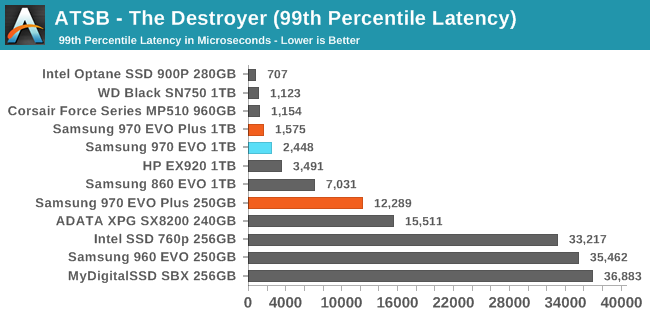
The average and 99th percentile latency scores for the 970 EVO Plus are a clear improvement over its predecessors, but it doesn't come out ahead of all the competition. The Phison E12-based Corsair MP510 outperforms the 970 EVO Plus on both metrics, and the WD Black SN750 has better 99th percentile latency.
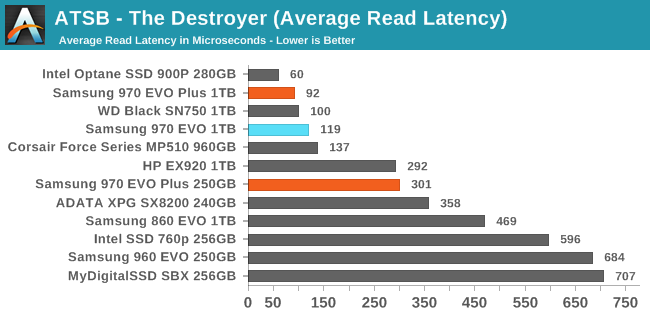
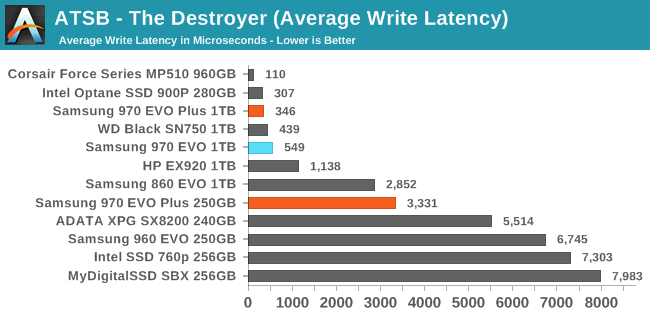
The 970 EVO Plus has a faster average read latency on The Destroyer than any of its competition, but the Corsair MP510 still holds the top spot for average write latency thanks to its very fast write cache. Among the slightly different mix of smaller drives, the 250GB 970 EVO Plus has a much more commanding lead in average write latency than average read latency.
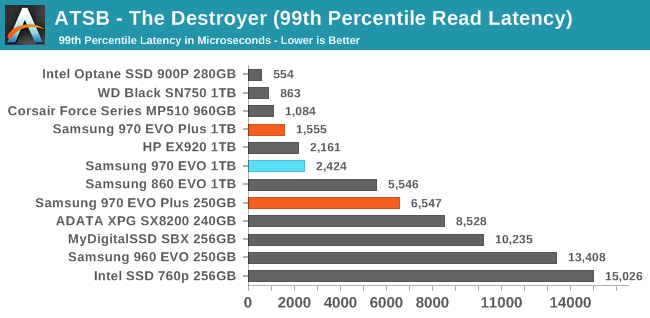
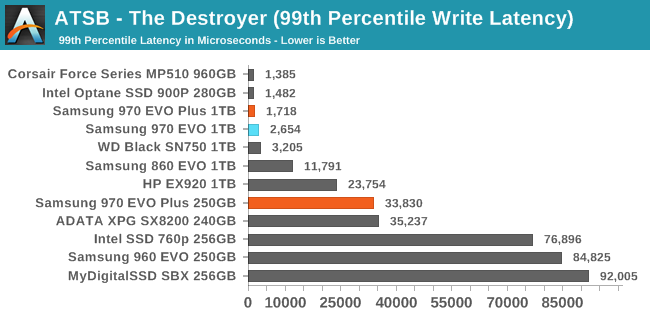
The 1TB 970 EVO Plus has better 99th percentile read and write latency scores than its predecessor, but it can't entirely catch up to the best competitors we've seen in recent months. The smaller drives have vastly higher 99th percentile latencies, but the 250GB 970 EVO Plus comes out ahead among that group with a small write QoS lead and a larger read QoS lead.

The 1TB 970 EVO Plus uses slightly less energy to complete The Destroyer than its predecessor. However, both capacities are still very inefficient compared to the best drives in their capacity class. At 1TB there are options that are both very efficient and very fast, but the only particularly efficient small NVMe drive we've tested is the entry-level MyDigitalSSD SBX.










35 Comments
View All Comments
Chaitanya - Tuesday, January 22, 2019 - link
Quite a minor upgrade over previous drive.jeremyshaw - Tuesday, January 22, 2019 - link
Hence the name.Billy Tallis - Tuesday, January 22, 2019 - link
More substantial than the WD Black SN750.I don't think we'll see any more big jumps until PCIe 4.0 ships. Pretty much everybody has caught up on the NAND side, and most of the controller vendors have had decent NVMe controllers out for a while. There's no low-hanging fruit like there was when companies were still trying to make SM2260 or Phison E7 compete against Samsung with inferior NAND.
DanNeely - Tuesday, January 22, 2019 - link
More to the point it is a consistent incremental improvement. There've been far too many cases over the years when a v.next drive was an incremental improvement in manufacturing cost, that regressed in most to all performance numbers.boozed - Tuesday, January 22, 2019 - link
I call those performance improvements significant (just).Flunk - Thursday, January 24, 2019 - link
I don't think it's enough to elevate this drive over the high-end Silicon Motion drives in real-world uses. Not for consumers at least.nectrone - Thursday, January 24, 2019 - link
96-layer nand is an improvement on production speed, yields, and manufacturing cost, rather than perf. And tbh, we don't need better perf at all, or maybe a bit in 4k random, because 150MBps is a bit low in 2019. Instead, what we need, is prices to drop, below twice the price of an hdd of the same capacity.In 2018, 1TB tlc nvme 64-layer ssd was 10 times the price of an hdd, now in Jan it's 5 times. Sata 64-layer ssd were 7 times the price of hdd, now it's 3. I'd like TLC nvme to cost twice an hdd, and sata tlc to be the same price as an hdd. With 96-layer, we'll get closer to that.
haukionkannel - Tuesday, January 22, 2019 - link
Pity that the consumer version does not get 4.0 this year... I was hoping to have 4.0 compatible ssd when AMD 570x boards comes out. Well most like with my usage even these Are fast enough and I am not going to be Bottle negged by 3.0.sorten - Wednesday, January 23, 2019 - link
I had the same reaction. I'm running an old gaming PC and I'm ready to switch to AMD with a full set of upgrades at the end of the year and was hoping for PCIE 4.0, but my SSD is so old that I know any drive will be a huge improvement.ikjadoon - Tuesday, January 22, 2019 - link
Meta: has the scrolling video ad been moved to the right? It finally doesn't cover up the article when you scroll. Huge thank you.970 EVO Plus: I'm excited for this to get added to the SSD 2018 Bench. Curious how close it matches the 970 PRO 512GB, now at $170. My almost-full 250GB 960 EVO needs a capacity increase and $40 isn't a big difference for a minimum two-year purchase.